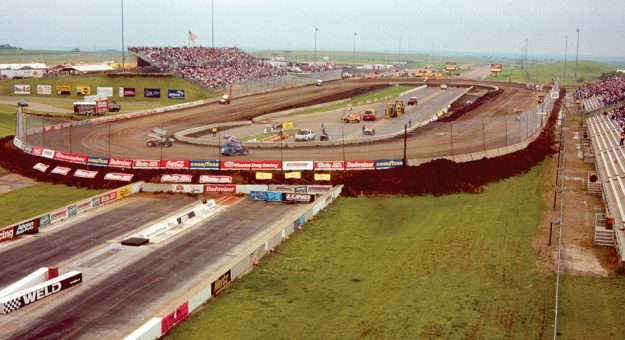In 1999, the World of Outlaws Sprint Car Series was breaking new ground. Series founder and owner Ted Johnson had inked an equity partnership deal with TNN.
In 1999, the World of Outlaws Sprint Car Series was breaking new ground. Series founder and owner Ted Johnson had inked an equity partnership deal with The Nashville Network, which was providing a hefty television schedule of live and tape-delayed events.
Meanwhile, Speedway Motorsports Inc. was looking to build dirt tracks on the grounds of the company‘s Charlotte Motor Speedway (then named Lowe‘s Motor Speedway) and Texas Motor Speedway in order to feature the Outlaws.
A dirt track on the grounds of Las Vegas Motor Speedway had been hosting the WoO since 1996. Additional dirt facilities at other facilities were also under consideration.
In the midst of these events, the management of Heartland Park Topeka (now Heartland Motorsports Park) — a prominent drag racing facility and road course — announced that they would be creating a temporary dirt oval to host several types of race cars with a two-day finale of the World of Outlaws sprint cars.
Owner Jay Landrum and track president Bill Kentling scheduled a speedweek that would culminate with a Friday night prelim and Saturday night finale, both to be broadcast live on TNN, on June 18-19.
Hall of Fame promoter Lanny Edwards was brought in as a consultant, but a local excavating company would handle the actual building of the track, as well as track prep for the race nights.
Some suitable clay was found on the grounds of Heartland Park, 23,000 cubic yards were trucked a short distance to the drag strip, and a temporary three-eighths-mile dirt track was constructed. The largest obstacle was the tight width between the pair of grandstands that sandwich the dragstrip and a section of the road course.
Though tracks like Pennsylvania‘s Williams Grove Speedway have often been described as paper clips, the temporary track at Heartland Park gave new meaning to the term.
Long straightaways and extremely tight, narrow corners made for an unusual track. In addition, there was little banking, as additional banking would mean building up the clay track surface higher, and losing visibility from the lower rows of the grandstands.
When the cars took to the track, the sound was highly unusual for a winged 410 sprint car event. Instead of keeping the throttle down and driving straight through the corners, drivers ran the course more like non-wing racers once piloted the now-defunct Ascot Park.
Engines roared and cars did wheelstands off the corners and then ran full-song down the stretch before drivers lifted almost completely off the throttle and backed the cars into the tight corner.
Throughout the pits, the sentiment was almost unanimous: drivers didn‘t like this track formation at all.

Other high-end racing facilities had expressed similar interest in creating either temporary or permanent dirt facilities in order to host WoO events, and Ted Johnson knew they would be watching the event at Topeka. Success or failure at Heartland Park might influence decisions regarding going forward at those other facilities.
So, at Friday‘s drivers meeting Johnson threatened a $5,000 fine for any driver that stated negative comments about the track in interviews.
The weather started off favorably on Friday, June 18, but forecasts predicting rain in the evening proved correct. Shortly after the program had attempted to get underway, a wave of showers came through.
After the rain passed, track crew drove out a pickup truck pulling a jet dryer regularly used on the drag strip and road course and began circling the oval. The dryer was quite effective.
“We have several promoters here from dirt tracks around the country, and when we brought the jet dryer out I saw several of them laughing.” Jay Landrum relayed to this writer with a smile. “But, in the past few minutes, some of those same promoters have come over to me and asked me where they can get them.”
Unfortunately, though the jet dryer had quickly gotten the racing surface back into near race-ready condition, another line of showers followed, with that storm lasting for several hours into the evening.
The night‘s racing was postponed, with the full two-day show shifted to take place on Saturday and Sunday evenings.
Saturday night saw a massive crowd; frankly, it was larger than Landrum and Kentling had anticipated. Eighteen thousand race fans packed the two grandstands.
While many drivers struggled, others excelled. Oklahoma‘s Andy Hillenburg didn‘t struggle. He suffered a broken brake line in the heat race, which put him deep in the feature, but from the moment the green flag dropped on Saturday‘s A-main he was moving forward.
Hillenburg had clearly figured out the odd paperclip, and put on a hell of a show, hard-charging through the field to earn the win.
“I remember that because it was a TV race, and (Brad) Doty came down after the race and was telling me, ‘I kept watching you come up through the field.‘” Hillenburg recalled.
“I remember it being real small when we were standing there looking at it. And then, once we got out there, I didn‘t think it was too bad,” Andy continued. “But, I mean, I grew up racing Ru-Jo (Raceway), which is now Port City, and I grew up running those little bitty tracks around here in Oklahoma so it really wasn‘t anything different to me.”
“It was very tight, and I do remember at that specific time in hot laps that maybe I was running the corner a little further. And we probably at that time had a little bit better brakes than anybody. That‘s when we were running those carbon fiber rotors that a lot of people didn‘t like. And the same way out at Chico and some places like that, real good brakes make a lot of difference. But, that was a pretty good little race track for me.”
To continue reading, advance to the next page.
